Last Updated on April 15, 2025 by Owen McGab Enaohwo
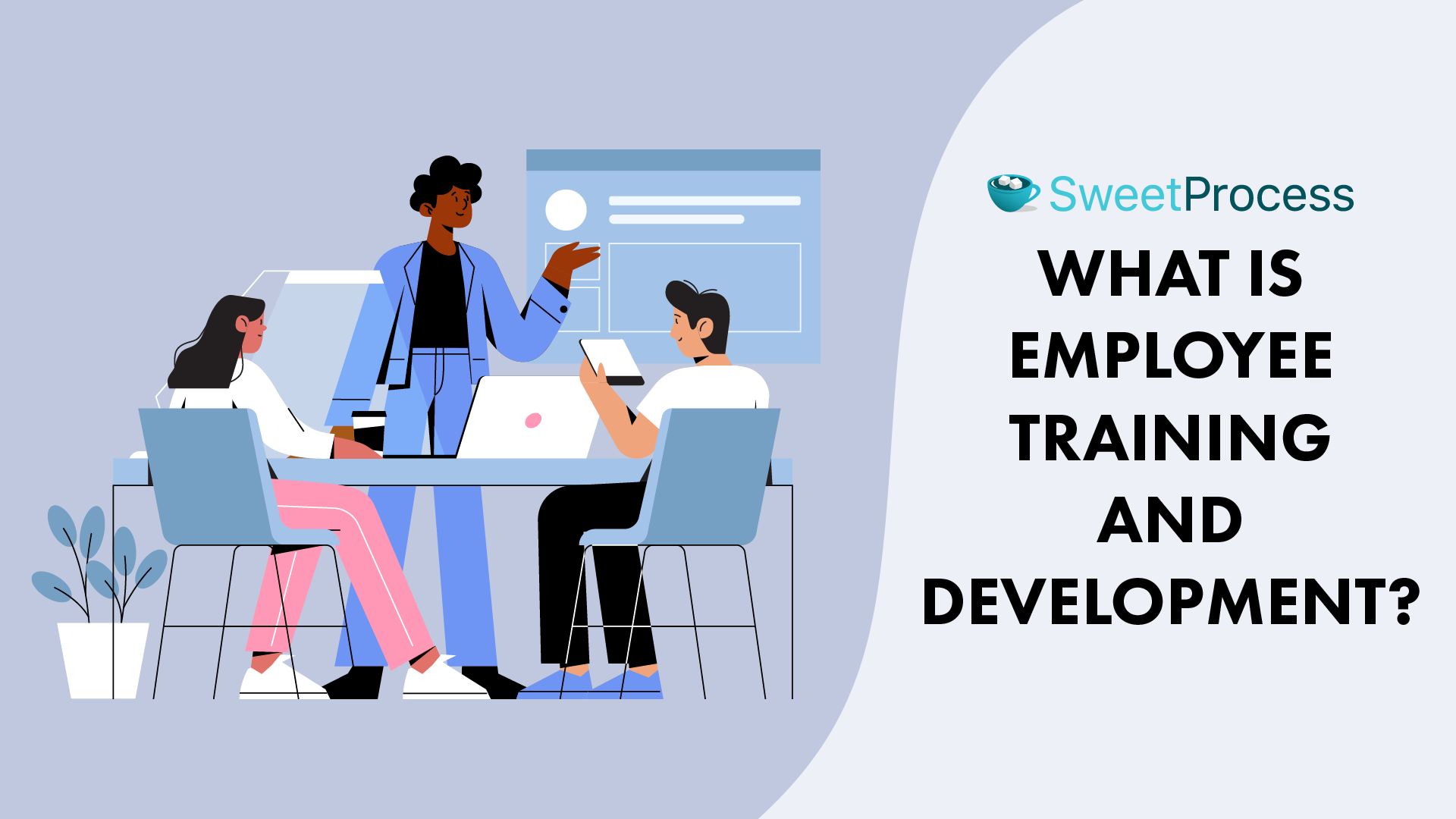
“Every enterprise is a learning and teaching institution. Training and development must be built into it on all levels—training and development that never stops.” Peter Drucker, Management Consultant, Educator, and Author
Employee training has become essential for every company striving to stay competitive and productive.
A recent study by the Association for Talent Development (ATD) found that companies offering comprehensive training programs have a 218% higher income per employee and a 24% higher profit margin than companies without formalized training. This underscores the competitive advantage of employee skill development.
With 87% of millennials and Gen Z workers prioritizing learning and development opportunities as key factors in job satisfaction, there is growing pressure to adapt training approaches to meet evolving employee needs. Yet, traditional training models are now extinct.
This article will explore the tools and trends to help you achieve modern employee training, from flexible, digital platforms to personalized learning paths.
SweetProcess is our tool, built with interactive, collaborative, and assessment features that aid employee training and development. Sign up for a free trial and enjoy all the features for 14 days.
What You’ll Learn in This Guide
What Is Employee Training and Development?
8 Benefits of Employee Training and Development
9 Steps to Create a Successful Employee Training and Development Program
How to Use SweetProcess for Your Company’s Employee Training and Development
13 Types of Employee and Development Training Programs [+ Case Studies]
5 Types of Employee Training and Development Tools
7 Employee Training and Development Trends for 2025 and Beyond
What Is the Difference Between Training and Development?
Train Your New Employees Effectively Using SweetProcess
What Is Employee Training and Development?

Employee training and development help employees acquire new skills, improve performance, and advance their careers.
Employee training focuses on teaching specific skills or knowledge necessary for an employee’s current role, and employee development prepares employees for future responsibilities and growth.
The combination of training and development processes is essential to foster a motivated and skilled workforce that contributes meaningfully to the company’s success.
An example of companies investing significantly in employee training and development is Starbucks.
They have a standardized Starbucks Coffee Academy dedicated to training employees in coffee production and processing skills. The academy covers topics such as bean sourcing, brewing techniques, and customer service.
Through this training, Starbucks employees gain confidence and expertise that directly impact customer experience while building employee skills for potential career advancement within and beyond.
Our emphasis on training and professional development supports Starbucks’ commitment to high-quality service and employee retention.
8 Benefits of Employee Training and Development
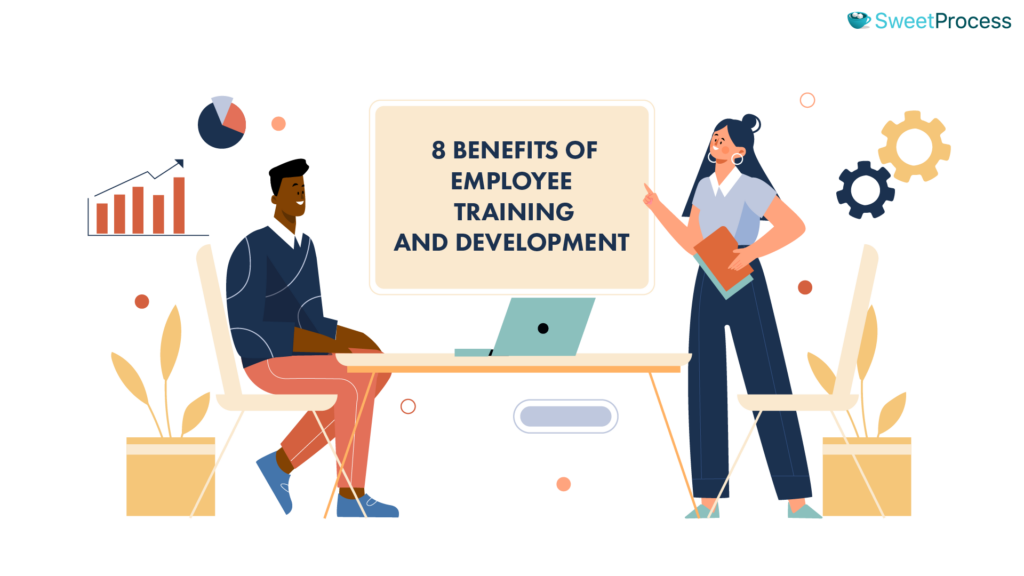
Some benefits of employee training and development for your company are highlighted below.
Cultivates a Positive Organizational Culture
Training and development reflect a company’s value for growth. They create a supportive and positive environment where employees feel confident and motivated to handle all their responsibilities.
Improves Employee Productivity and Performance
Employees with the required skills work more efficiently and effectively, boosting the company’s overall productivity and output quality.
Promotes Knowledge Transfer and Collaboration
Training provides an enabling environment for employees to exchange ideas and insights. This will foster teamwork and innovation across departments.
Builds Customer Satisfaction and Loyalty
Well-trained employees deliver better customer experiences. A great experience will bring about higher satisfaction, trust, and loyalty.
Increases Employee Engagement and Retention
Investing in development helps employees feel valued, leading to higher job satisfaction and reduced employee turnover.
Strengthens Company Reputation and Demand
Organizations known for prioritizing employee development programs will attract top talents and gain a strong reputation within their industry.
Enhances Workplace Safety and Compliance
Companies that prioritize training will mostly integrate safety and compliance as part of training modules. Safety and compliance education ensures employees understand and adhere to regulations, reducing workplace accidents and legal risks.
Reduces Employees’ Skills Gaps
A well-planned employee training will provide all the essential skills each employee needs at all levels. This will address skill shortages and ensure employees have the capabilities to meet both current and future demands.
9 Steps to Create a Successful Employee Training and Development Program
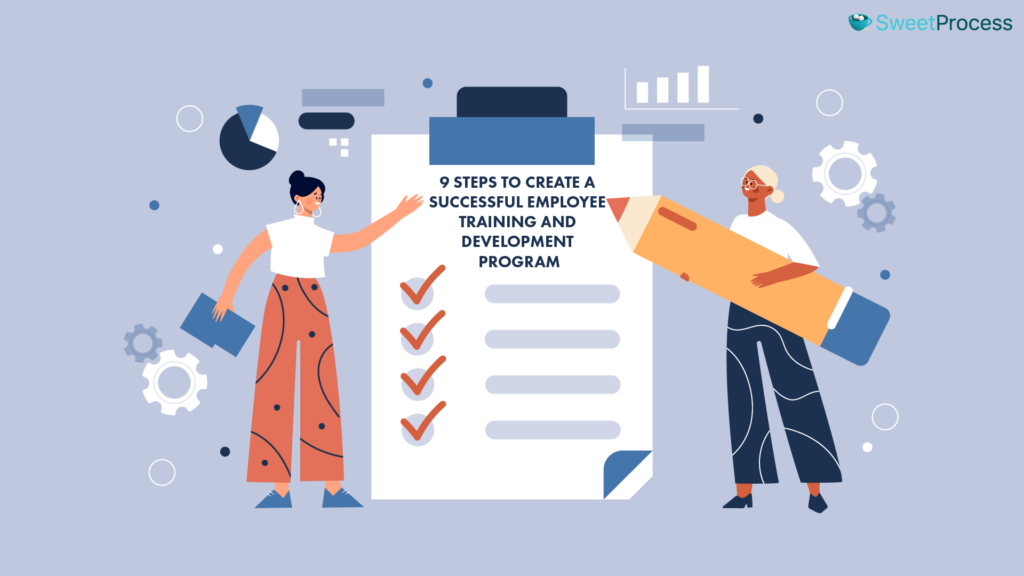
1) Set Clear and Tangible Goals
Identifying specific outcomes you want from any training program and connecting them to real company needs is essential.
For example, if you’re launching a new CRM system, a goal might be for all sales staff to become fluent in using its key features within one month.
Setting such measurable goals helps employees see the direct purpose of their training and also allows you to track progress.
2) Analyze Skill Gaps and What’s Needed
Think of this step as doing a skills “inventory.”
Let’s say you’re expanding a digital marketing team to include social media advertising.
If no team member has advanced skills in paid social media, then it’s time to prioritize training in that area.
This approach ensures resources go where they’re most needed, making the training program highly relevant.
3) Ensure Employee Buy-In
To make the best out of employee training, employees themselves must value the training.
For example, employee buy-in is needed if your company plans to implement AI-driven software to speed up customer service responses.
You need to show your employees how this training will make their day-to-day tasks easier or prepare them for future roles. This will motivate them to engage with the training and benefit from it.
4) Offer Ongoing Training
Skill-building shouldn’t be a one-off training. Companies like The Rise Journey offer regular “Lunch and Learn” sessions on new tools or industry trends. Such sessions enrich workplace education through interactive discussions with subject matter experts. Thus, they keep employees up-to-date, helping them remain flexible and informed in their roles.
5) Review Progress Regularly
Keep an eye on learning progress with periodic assessments or check-ins. Imagine a sales team working toward a target after training on advanced negotiation tactics. Regular check-ins will help track if the team is applying these new skills effectively, providing a chance to address any gaps along the way.
6) Invest in Valuable External Opportunities
Sometimes, the best knowledge comes from outside the company. For example, sending employees to a popular industry conference will bring them new insights and allow them to network with others in the field, often sparking ideas that benefit the whole team.
7) Provide Employee Incentives
Offering rewards, like a certificate, bonus, promotion, or even a dedicated project after training, makes the effort feel worthwhile. Consider a customer service representative who, after completing a challenging communications training, is given a leadership role in resolving key customer issues—showing how their hard work translates into real opportunities.
8) Pay Attention to Employee Feedback
Employees are often the best source of insight for improving training. If a group of new hires finds the onboarding process overwhelming, their feedback can help streamline the program to better meet their needs, making future training smoother and more effective for everyone involved.
9) Review and Update Continuously
Industries change quickly, and so should your training and development programs. For example, threats in cybersecurity evolve constantly. Regularly refreshing training modules ensures that employees are prepared for new challenges and able to adapt, giving the company a competitive advantage.
How to Use SweetProcess for Your Company’s Employee Training and Development

SweetProcess is an excellent tool for creating, organizing, and managing all elements of employee training and development.
It comes with features tailored for creating and documenting workflows, policies, processes, collaborative tasks, and training assessments.
SweetProcess streamlines how employees learn, follow procedures and stay informed of company standards.
SOP Creation and Management in SweetProcess
Standard operating procedures (SOPs) are the backbone of consistent training.
SweetProcess allows you to easily create and manage SOPs and make them accessible to all team members.
You can create a detailed SOP for new hires on handling customer inquiries to guide them step-by-step through the process.
Follow these steps to create an SOP in SweetProcess:
Step 1: Log in to your SweetProcess account or create a new account for free.
Step 2: Click on “Create Procedure.”
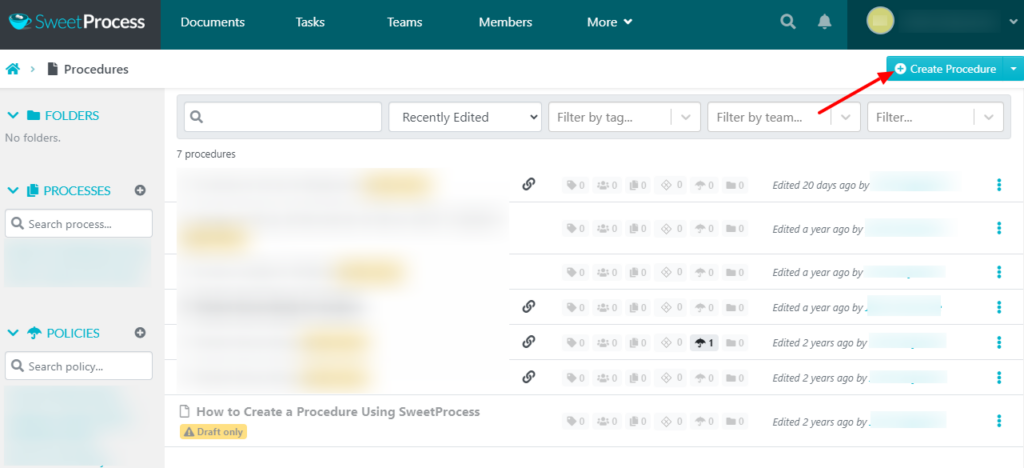
Step 3: Input the title of the procedure.
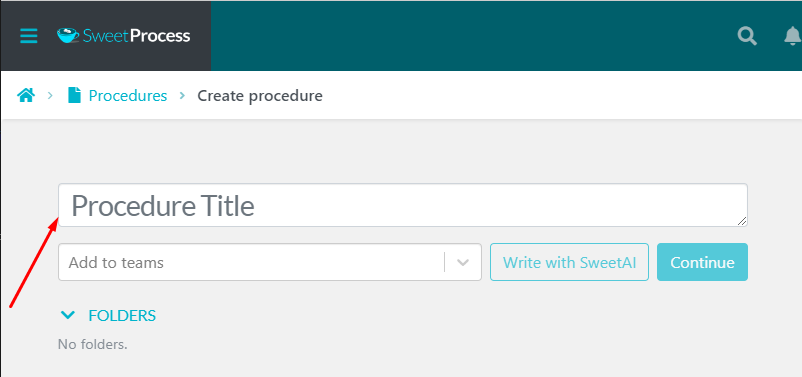
Step 4: Click on “Add to teams” to select the team that should access the procedure.
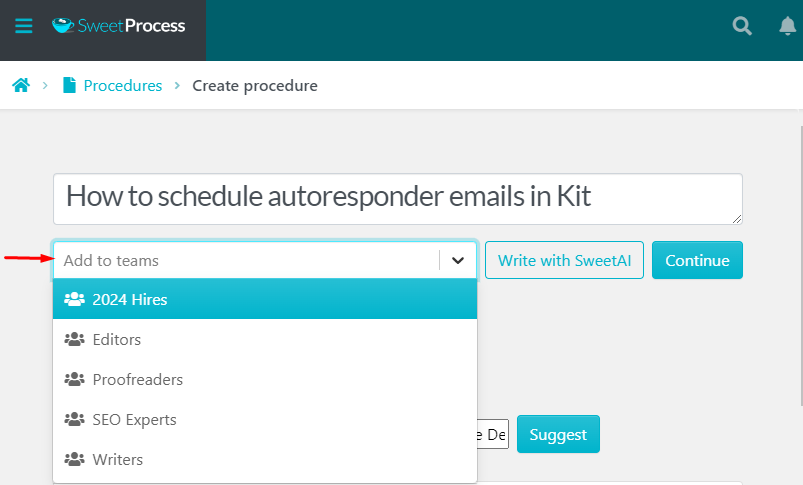
Step 5: Click on “Continue” if you want to input the procedure details personally. Alternatively, you can have an AI-generated procedure in 30 seconds using the “Write with SweetAI” feature.
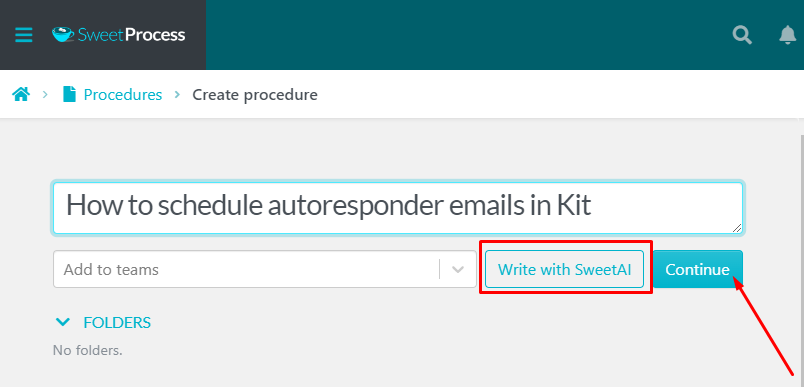
Step 6: Once you’ve added the procedure steps, you can edit or enrich with features like images, videos, tables, and links.
Step 7: Approve the document or request approval from the right team member. Then, your procedure goes live.
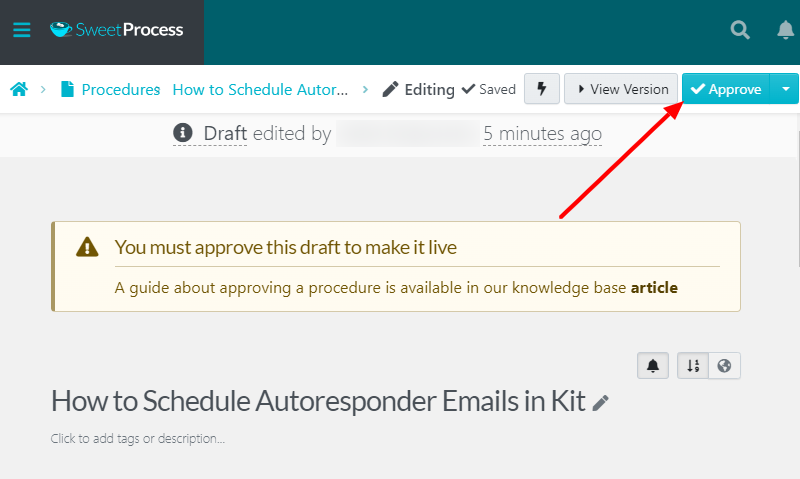
By documenting procedures in SweetProcess, you can easily bridge the gap between experienced and inexperienced employees.
According to Don Houk, the president of Next7 IT, employees can only be as good as what they know. This underscores the importance of training your team members with a tool with no learning curve, like SweetProcess.
In his words, Don said, “If you can have some experienced people write a good procedure, then you can give that procedure to somebody that maybe doesn’t have as much experience, and then they can go do it and get the same result as if that more experienced person had done it.”
The team at Next7 IT picked SweetProcess among other tools at a time when they got tired of keeping their processes in Word documents.
Policy Writing and Management in SweetProcess
Company policies are essential for setting expectations and guidelines, and SweetProcess simplifies policy documentation and its management.
Here’s how to create a policy in SweetProcess:
Step 1: Log in to your SweetProcess account or create a new account for free.
Step 2: Click on “More” and select “Policies” from the drop-down.
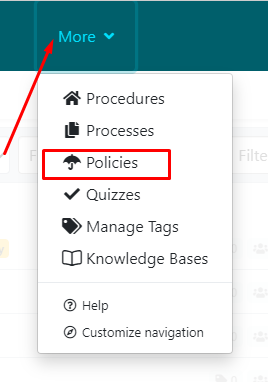
Step 3: Click on “Create Policy.”
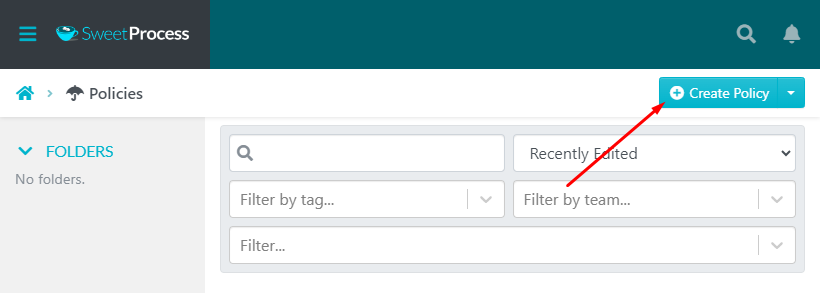
Step 4: Input the policy title and select the appropriate team for the policy.

Step 5: Click on “Continue” to add the policy statements, or click on “Write with SweetAI” to write your policy using our AI feature.
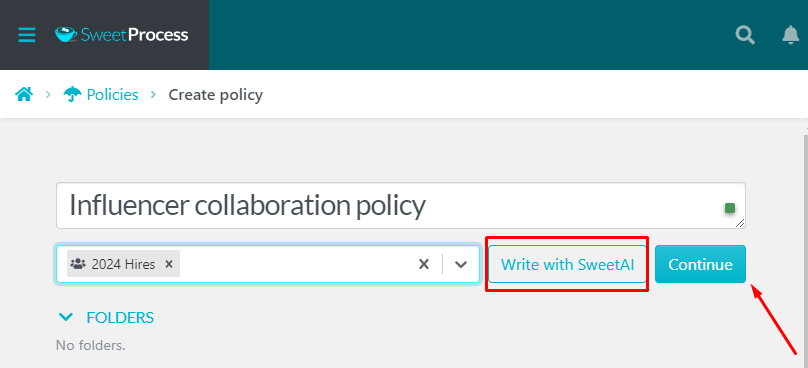
Step 6: You can edit the policy manually or edit with SweetAI. SweetAI editing is enabled as soon as you get to the editing interface.
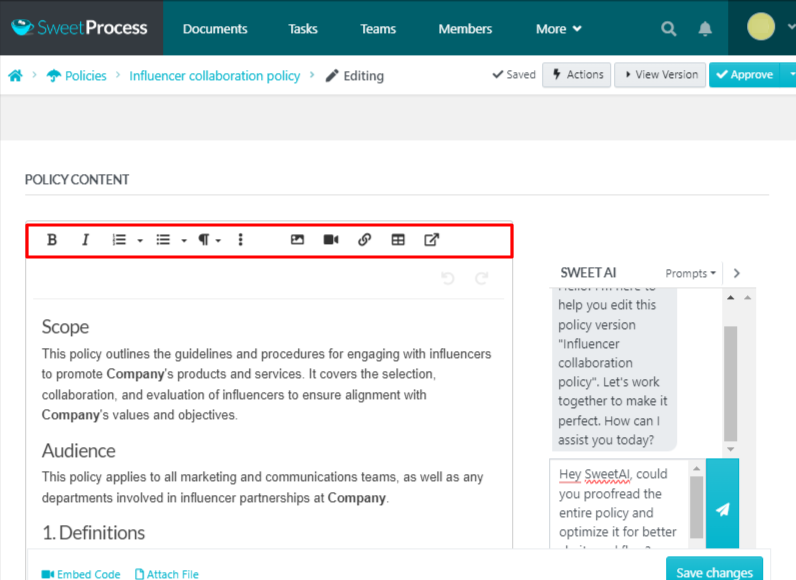
You can also add details like images, videos, and links to your policy document.
Step 7: Once the editing is complete, you can approve the policy to make it go live or request approval from the right team member.
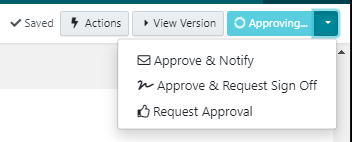
Knowledge Base Creation and Management in SweetProcess
A detailed and organized knowledge base is an invaluable resource for employees’ self-guided learning.
With SweetProcess, you can compile guides, FAQs, and training materials that employees can access when needed.
The knowledge base feature in SweetProcess is useful because it allows you to differentiate between the private (employees’) and public (customers’) knowledge bases.
Follow these steps to create a private knowledge base for your employees in SweetProcess:
Step 1: Log in to your SweetProcess account or create a new account for free.
Step 2: Click on “More” and select “Knowledge Bases.”
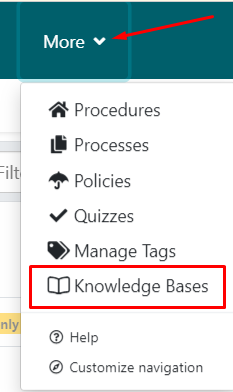
Step 3: Click on “Create Knowledge Base.”
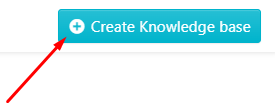
Step 4: Name the knowledge base and click “Continue.”

Step 5: Click “Control Access” on the interface displayed to switch between public and private knowledge bases.

Step 6: Select “Private Knowledge Base” if you intend to dedicate it to your employees.

Also, choose your desired preference for other options on the control page.
Step 7: Start by creating your first category or section. Click on “Create Category.”

Step 8: Populate the knowledge base by adding existing documents or creating new ones.
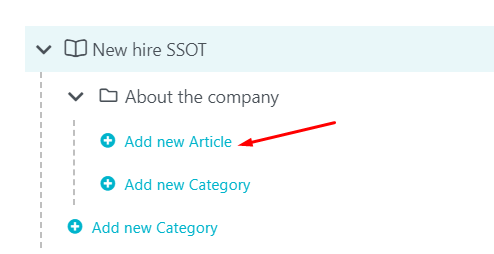
Once you have added all the training documents to your knowledge base, you can share them with the right team members.
You probably agree that experienced employees tend to portray competence in discharging their duties.
Most companies struggle with knowledge transfer, making bringing newer employees up to speed challenging.
This was the case at Everywhere Wireless, an internet service provider company, according to Tom Vranas, the vice president of innovation and culture.
Tasked with business process improvement, Tom Vranas practically tried out 70 similar software to see which would give the best outcome. After three months of testing and demos, he chose SweetProcess, and it was and is still a game changer.
Apart from documenting their processes, the decentralized knowledge base in SweetProcess became their company wiki, and their employee onboarding improved.
Tom’s options were clear—he wanted a system that managed their SOP and knowledge base in one place. The answer was SweetProcess.
Task Management in SweetProcess
Managing training-related tasks and other projects is straightforward with SweetProcess. You can assign specific tasks to employees, set due dates, and track completion.
If you want to assign tasks on SweetProcess, here’s how:
Step 1: To assign a task, it’s important to first have such a task documented as a process or procedure.
Step 2: Navigate to the procedure you want to assign as a task and click on the three dots beside it.
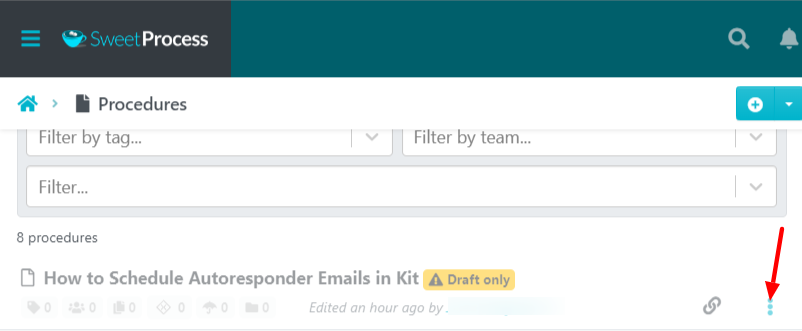
Step 3: From the drop-down options, choose “Assign as Task.”
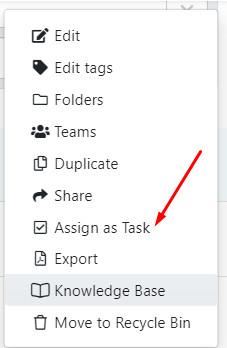
Step 4: Select the teammate(s) who should work on the task and click “Next.”
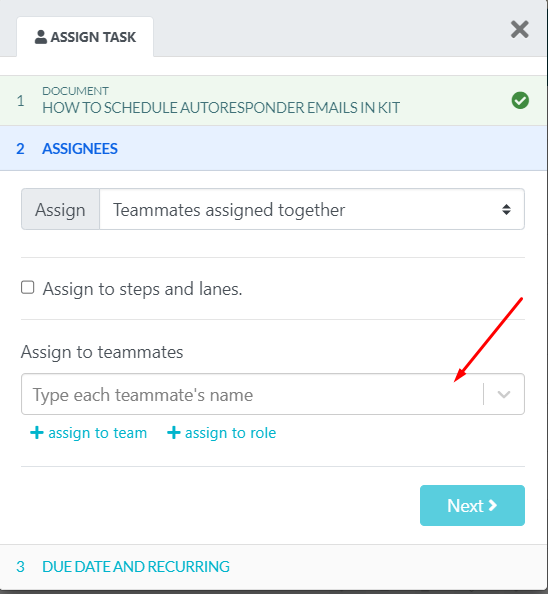
Step 5: On the next interface, input the task name, due date, and frequency of the task.
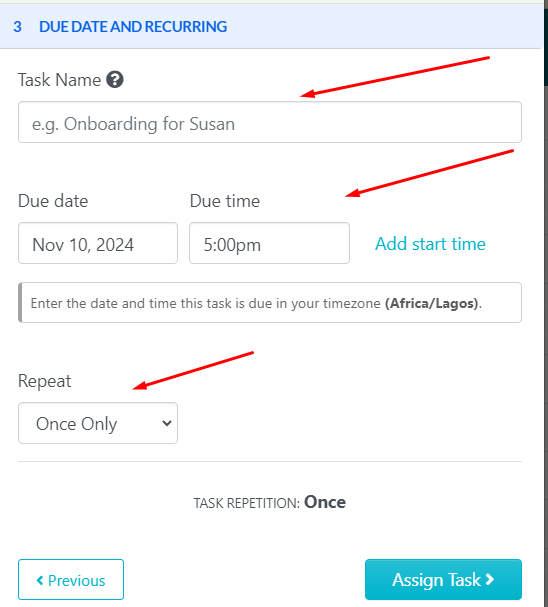
Step 6: Click on “Assign Task,” and the team members assigned are notified of all the details you shared within the task.

The team member(s) will also get an email notification on the due date.
The task assignee will get regular updates when the task is complete, due, or overdue.
Team Collaboration in SweetProcess
Effective training often requires collaboration, and SweetProcess makes it easy for team members to communicate and work together on training-related projects.
Your team members can comment, leave feedback, add questions, and suggest updates to procedures. This will help to measure the impact of the training and ensure that training materials stay relevant and accurate.
If you want to comment on or add feedback to a policy, process, or procedure document in SweetProcess, open the document and use the comment icon on the left side of the screen.
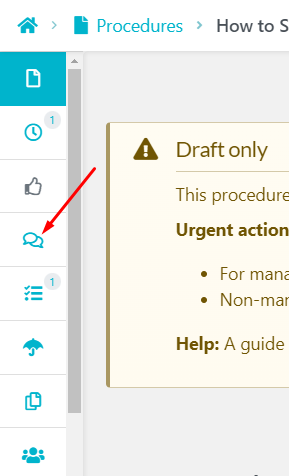
Knowledge Assessment in SweetProcess
SweetProcess helps you build an effective employee training program. One of the most helpful features here is the quiz feature.
You can assess the comprehension level of your employees on each or all of the training modules.
Follow these steps to create quizzes and test your employees’ knowledge:
Step 1: On the SweetProcess home page, and click on “More.”

Step 2: Select “Quizzes.”
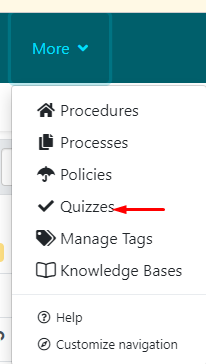
Step 3: Select “Create Quiz.”
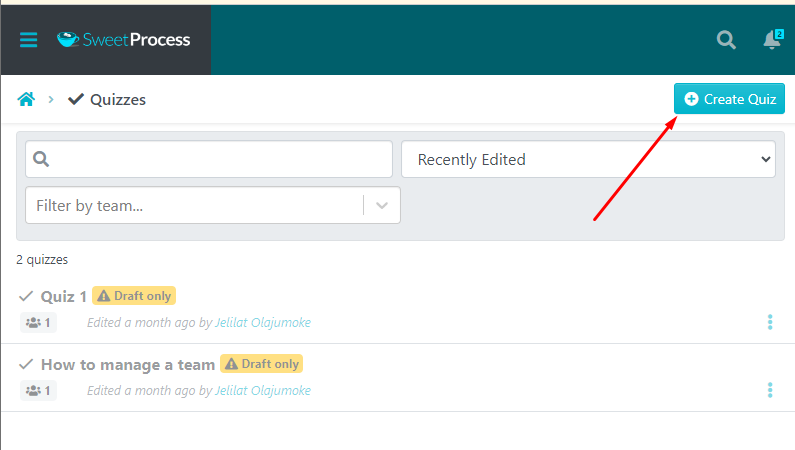
Step 4: Give the quiz a name.
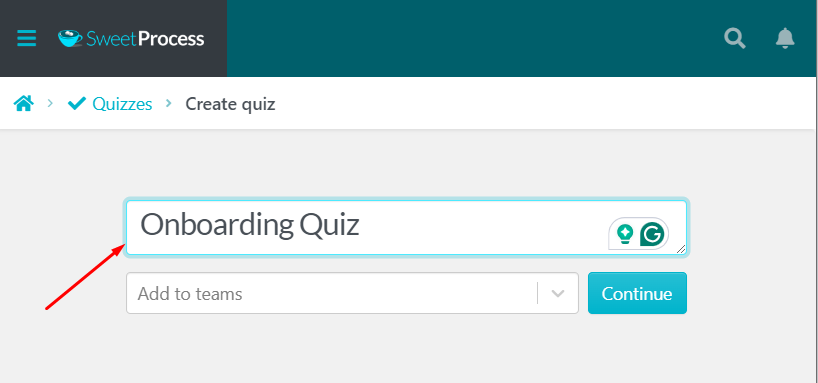
Step 5: Assign the quiz to the appropriate team on SweetProcess and click “Continue.”
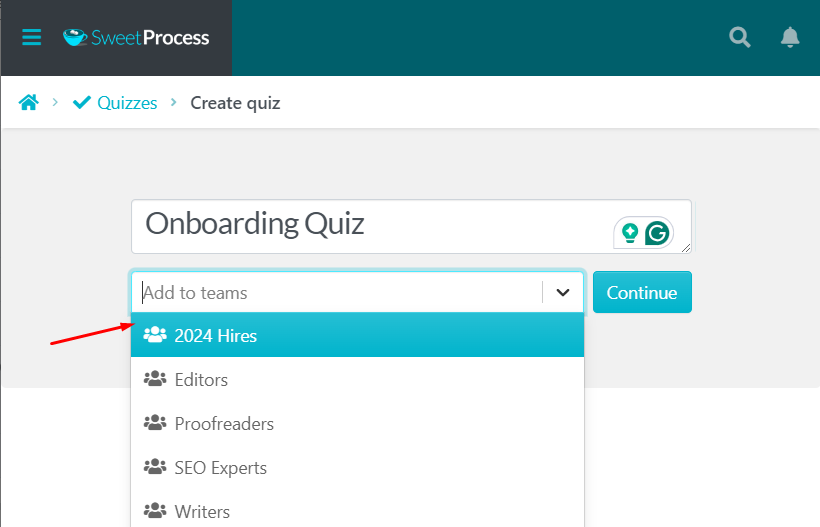
Step 6: Now, you can begin crafting multiple-choice questions about your company’s new procedures, policies, or processes.

Step 7: Choose the type of quiz: multiple-choice or open-ended answer.

Step 8: Click anywhere above the question section to assign duration and pass marks for the quiz.
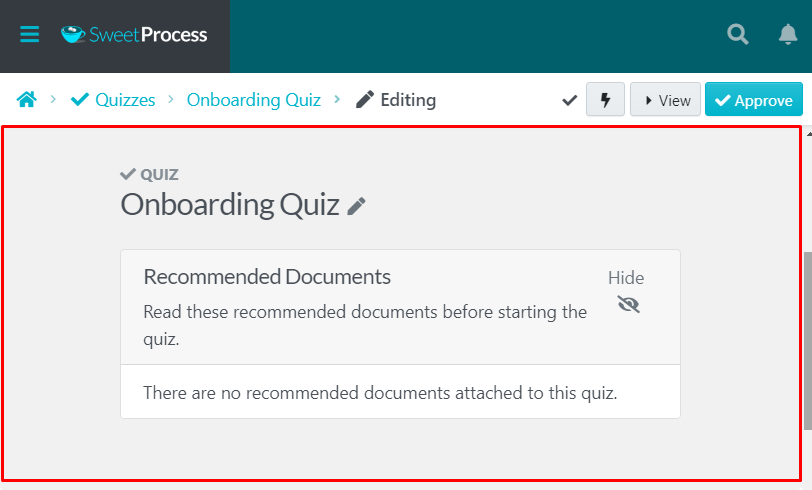

Step 9: Click “Save changes” after selecting your preferred duration and pass mark.
Step 10: Attach one or more documents related to this quiz to enable a cohesive learning and testing environment.

Step 11: Approve the quiz after adding all the questions as required.
Sign up here to create your first quiz in SweetProcess at no cost.
13 Types of Employee and Development Training Programs [+ Case Studies]
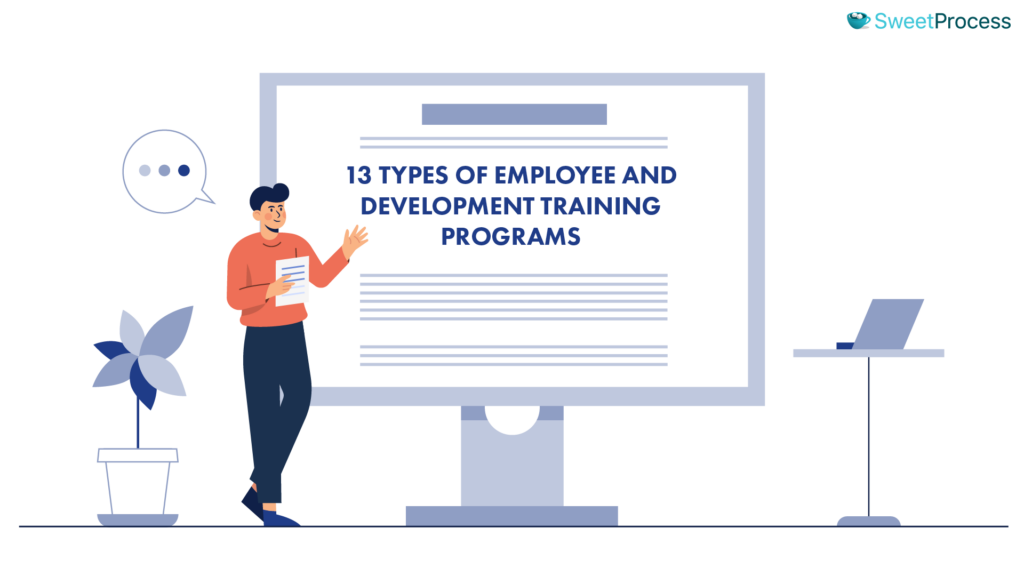
1) Technical and Soft Skills Training
Technical and soft skills training will equip employees and make them highly skilled and adaptable.
Amazon, for example, places high importance on technical and soft skills training with Amazon’s Virtual Contact Center. They train employees on technical customer service tools while emphasizing soft skills like empathy and communication.
This dual focus helps Amazon deliver consistent, customer-centric service across all its channels.
2) Leadership Development and Management Training
Leadership training prepares current and aspiring managers for skills like strategic planning, conflict resolution, and performance management.
Google’s Manager Development Program is a good example of leadership training that empowers managers to inspire their teams.
This program combines coaching, feedback sessions, and situational exercises to build leaders who can effectively guide Google’s diverse teams.
3) Safety and Compliance Training
Safety training educates employees on regulations and procedures to maintain a safe workplace. Compliance training also ensures employees understand and follow industry standards and legal requirements.
Coca-Cola offers a comprehensive safety and compliance training program for factory workers that includes regular training sessions, digital modules, and on-site safety drills.
This program ensures Coca-Cola employees follow safety protocols and compliance standards, reducing workplace incidents and regulatory issues.
4) Customer Service Training
Customer service training enhances active listening, empathy, and problem-solving skills to ensure employees can deliver excellent service to boost customer satisfaction and loyalty.
Zappos is a company known for its excellent customer service. Their secret is having all new employees complete a month-long training program, even if they’re not in customer-facing roles.
This training helps employees understand and embody Zappos’ commitment to exceptional customer service and prioritizing customer satisfaction.
5) Product Knowledge Training
Product knowledge training helps employees understand the ins and outs of the company’s offerings. It helps them to confidently communicate features and benefits to customers.
Apple trains its store employees extensively on product knowledge to ensure they can confidently assist customers with purchasing decisions and troubleshooting.
Apple’s “Today at Apple” sessions and internal training modules equip employees to be knowledgeable brand ambassadors who will always enhance customer experience.
6) Mentoring and Coaching
Mentoring is achieved by pairing less experienced employees with seasoned mentors. Similarly, coaching provides ongoing guidance to help employees meet personal and professional goals.
Intel uses mentoring and coaching extensively to support employee growth and leadership development.
Through its Intel Mentoring Initiative, Intel employees at all levels are paired with experienced mentors to get guidance on career development, skill-building, and navigating company culture.
7) Sales Enablement Training
Sale enablement training covers areas like product positioning, objection handling, and closing techniques. It is focused on giving sales teams the knowledge, skills, and tools to sell effectively.
HubSpot offers ongoing sales enablement training that includes product knowledge, customer targeting strategies, and handling objections.
HubSpot’s sales teams are also given tools and resources, such as the HubSpot CRM, to help streamline their sales processes and improve conversion rates.
8) Customer Education Training
Customer education is the process of providing customers with the information, skills, and tools they need to understand and use a product or service effectively.
Salesforce’s Trailhead program offers a unique approach to customer education.
They provide free, self-guided learning paths to help users get the most out of Salesforce’s products.
This approach empowers customers and boosts user satisfaction and product adoption rates.
9) Simulations and Role-Playing
This is an interactive training method that gives employees a chance to practice real-world scenarios in a controlled environment.
Wells Fargo integrates simulations into its training for customer service and sales teams.
These simulations allow employees to practice handling customer objections, difficult interactions, and compliance scenarios in a controlled setting.
By practicing in advance, Wells Fargo employees are better prepared to handle real-life situations confidently.
10) Conferences and Seminars
Conferences and seminars expose employees to new industry trends, insights, and networking opportunities.
Microsoft encourages employees to attend industry conferences like Microsoft Ignite, where they can learn about cutting-edge technology and connect with industry experts.
Microsoft often sends team members to relevant conferences to encourage professional growth and generate new ideas.
11) Workforce Training
Workforce training addresses general workplace skills, from basic computer literacy to teamwork and time management. Workforce training ensures employees have essential skills that support daily operations.
McDonald’s offers extensive workforce training through its Hamburger University.
The training covers essential skills like team collaboration, time management, and customer service.
This training helps McDonald’s maintain consistent service quality across its thousands of locations worldwide.
12) Corporate Training
Corporate training encompasses programs that reinforce company-specific skills, values, and knowledge. It might include onboarding sessions, corporate policy refreshers, and culture-building exercises that align employees with the company’s mission.
IBM is a master in corporate training programs that cover essential skills, policies, and cultural alignment to support its global workforce.
Its Think Academy provides training that reinforces IBM’s core values and strategic goals, ensuring employees are aligned with its mission and innovation-driven culture.
13) Diversity, Equity, and Inclusion (DEI) Training
DEI training promotes a workplace culture that values and respects diversity, reduces bias, and improves inclusivity.
LinkedIn conducts DEI training to create an inclusive workplace culture.
They hold workshops and training on topics like unconscious bias and cultural sensitivity.
This has helped LinkedIn foster a respectful and diverse work environment where employees feel valued and empowered to contribute their unique perspectives.
5 Types of Employee Training and Development Tools

Depending on your company’s focus and employee training and development objectives, a handful of tools can ease the process. Below are the types and examples of tools that can be used in employee training and development.
1) Knowledge Base Software
A knowledge base software is a single source of truth that you can use to organize information, guides, FAQs, and resources in a central location. Employees and even customers can access it for self-directed learning, troubleshooting, and reference materials.
Examples of knowledge-based software tools are SweetProcess, Confluence, and Zendesk.
2) Learning Management System (LMS)
An LMS is a software application for delivering, tracking, and managing employee training programs. It enables employees to complete courses, track progress, and receive certifications.
Examples of learning management systems you can choose from are SweetProcess, Moodle, and TalentLMS.
3) Project Management Tool
Project management tools help employees manage tasks, collaborate on projects, and monitor project timelines. They often include features for scheduling, task assignment, and team communication.
Examples of project management tools you can choose from are SweetProcess, Asana, and Process Street.
4) Video Training Tool
These tools allow companies to create, share, and deliver training videos or on-screen instructions to employees. They are useful for remote teams or for presenting complex information visually.
Examples of video-enhanced training tools are Wistia, Loom, and Vimeo.
5) In-App Training Tool
These tools offer on-the-job, interactive training within an application. They guide employees through new software or tasks directly in the interface where they work.
Examples of in-app training tools are SweetProcess capture, Whatfix, and WalkMe.
Each of these tools provides a unique experience in enhancing employee learning and ensuring ongoing development.
7 Employee Training and Development Trends for 2025 and Beyond

With the rapid rate of technological advancement, areas such as workplace dynamics and employee expectations are also evolving.
Hence, this section is dedicated to exploring the innovative approaches that support continuous learning, adaptability, and professional development.
Here are some strategies that forward-thinking companies are adopting to build resilient, future-ready teams.
Personalization
Every employee is at different levels when learning about your company. They also have different strengths and weaknesses.
For example, one employee may prefer video training, while another may prefer text-based training materials. Your organization can improve knowledge retention and skill acquisition by tailoring training to individual needs and learning styles.
According to a study by IBM, personalized learning can improve employee performance by up to 19%.
Microlearning
You can also refer to this as bite-sized learning. Microlearning involves breaking down complex topics into smaller, easily digestible modules that enhance learning efficiency.
Gamification
Gamification techniques like points, badges, and leaderboards provide a more engaging learning experience and can increase motivation and engagement.
Gamified learning can enhance information retention by making training more fun and interactive. A study by Gartner found that gamification can increase employee engagement by up to 40%.
Artificial Intelligence
AI-powered algorithms can create customized learning paths for each employee toward personalized learning paths.
By automating administrative tasks, AI will free L&D professionals to focus on strategic initiatives.
Social Learning
Social learning is a collaborative learning style that fosters knowledge sharing and collaboration among employees.
It mostly comes from mentorship and coaching, where peer-to-peer mentoring can accelerate skill development and career growth.
A study by Deloitte found that social learning can increase employee engagement by 20%.
Mobile Learning
Mobile learning provides flexible learning opportunities where employees can access training materials anytime, anywhere.
A survey by Adobe found that 70% of employees prefer to learn on mobile devices. This is because mobile devices make learning more accessible to a wider range of employees.
Data-Driven Training
Data-driven training is a data-backed opportunity to measure training effectiveness.
With data analytics, your organization can track key performance indicators (KPIs) and measure the impact of training programs.
What Is the Difference Between Training and Development?
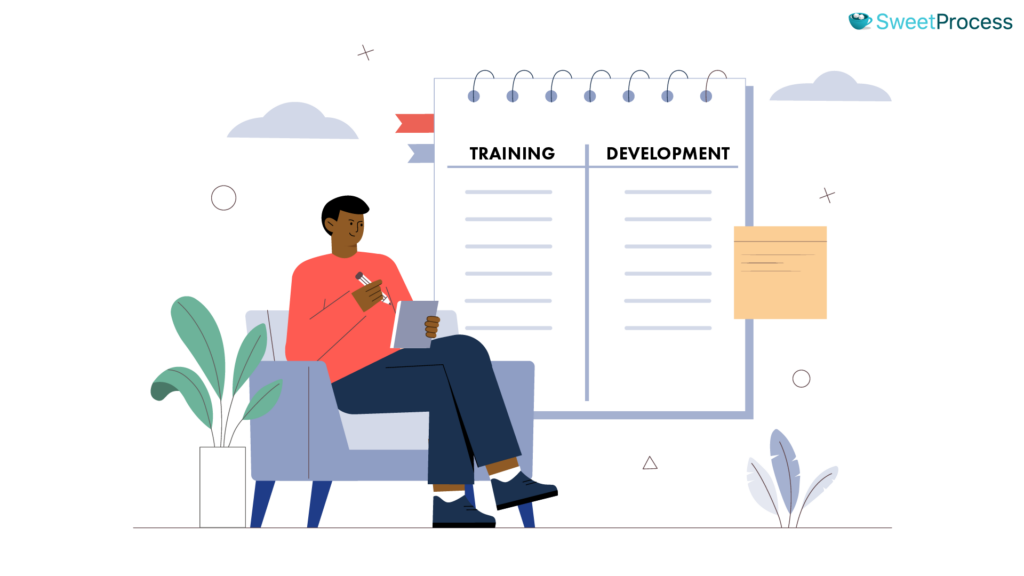
Imagine you’re learning to cook.
Training would involve learning a specific recipe, like how to make a perfect omelet. It’s focused on a particular skill, and you’re learning it to do your current job better.
An example of this is “How to set up an autoresponder email” for an internet marketing company.
On the other hand, employee development is like learning to be a chef. It’s broader and focuses on your overall skills and potential. You might take a class on food science, learn about different cuisines, or even get a business degree to manage your own restaurant.
In the example above, if you’re an employee of an internet marketing company, you can go as far as enrolling in courses centered around digital marketing, pay-per-click marketing, email deliverability, affiliate marketing, search engine optimization, influencer marketing, and so on to develop your technical skills.
Both training and development are important for employees and organizations. Training ensures people can do their jobs effectively, while development helps them grow and advance their careers.
Train Your New Employees Effectively Using SweetProcess
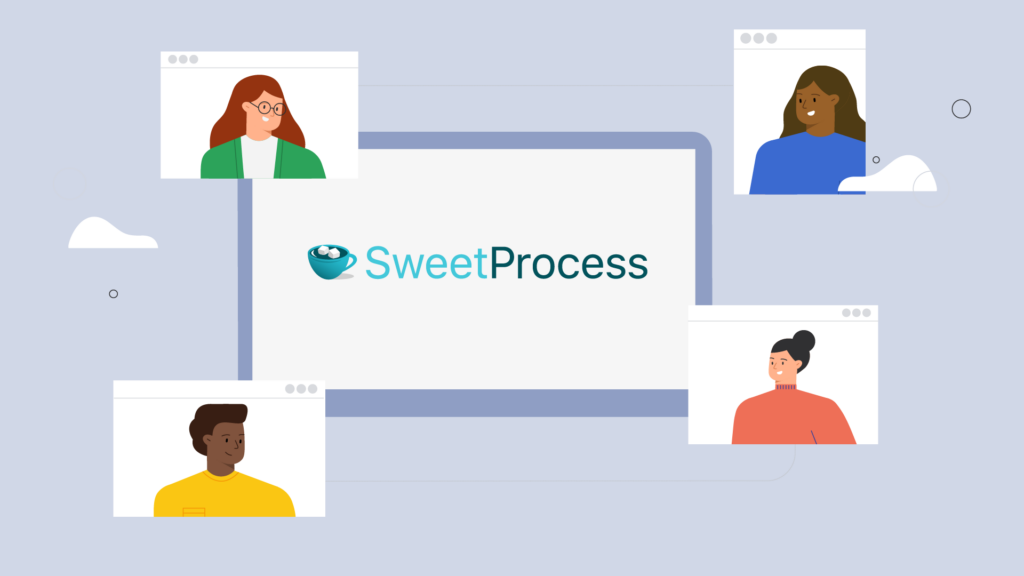
It is easy to blame employees for their inability to execute their tasks effectively. However, an organization can’t exonerate itself from the incompetence of its employees if it doesn’t provide them adequate training.
Likewise, it’s one thing to have the training resource packed on a platform for your new hires to learn. It’s another to ensure that they can navigate the platform well enough to get the most out of the training.
Without access to the best training resources, new hires are only expected to remain ignorant, do the wrong thing, or bombard their supervisors with questions.
SweetProcess is a no-brainer tool that new hires can use without any technical knowledge.
Jacob Syrytsia, Chief Executive Officer at AEJuice, explained how Sweetprocess became a self-based learning platform in their company.
He said, “When somebody joins, I send them some links to the SweetProcess and say just watch this, read this, and get back to me when you are ready. It’s like self-based training.”
Having all the necessary knowledge packed in SweetProcess helped Jacob reduce the time required to train new employees or answer questions from existing employees.
Join SweetProcess today and establish your company’s self-based training platform.
